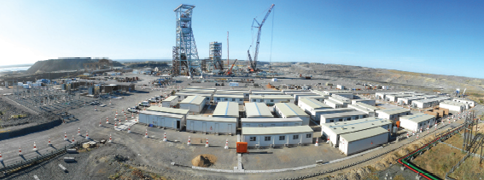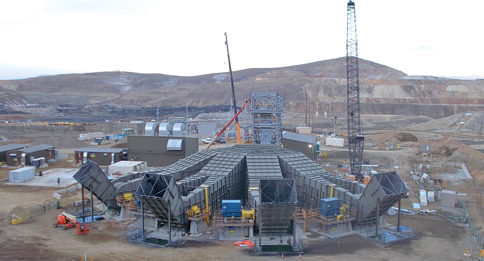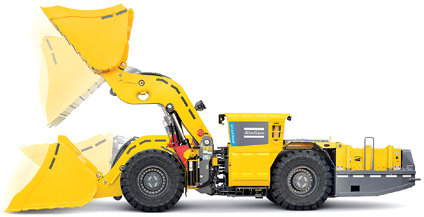Can technological advances relieve some of the economic pressure that’s stifling greenfield mine development?
By Russell A. Carter, Managing Editor
Underground mine development is hard. It’s a complex, time-consuming process that can involve hundreds of people, thousands of decisions and often upward of a billion dollars in investment. It requires workers with specialized skills, poses more than a modicum of risk, and despite careful preplanning and exhaustive engineering attention, doesn’t always result in a favorable outcome.
As new deposits are found at greater depth and in remote locations far from industrial centers or infrastructure, development becomes even more complex from logistical, labor, materials procurement and quality control aspects.

De Beers is currently investing more than $2 billion to convert the Venetia open-pit mine in South Africa into an underground operation. (Photo: De Beers)
Greenfield Development: Deflated?
Exploration and development spending is the air that floats the industry’s balloon, but in today’s capital-short, cost-conscious mining environment, that balloon appears to be underinflated. Moody’s Investor Services expressed concern in a research note, which observed that in recent years many of the investments that have been made by gold producers, for example, don’t seem to be resulting in additional production.
“…This points to suspended development projects,” said the Moody’s report. “This risk has become especially pronounced as we look beyond the next two years, when we anticipate future production could decline as a result of diminished spending on growth and development in favor of conserving cash.”
Looking beyond gold to other mining sectors, SNL Metals & Mining noted recently, “Over the past 15 years, exploration budgets have been shifting away from the grassroots work upon which new discoveries largely depend. With risk aversion continuing to plague the sector, companies are focusing their exploration activity on existing or developing mines to ensure an adequate level of reserves to support production.”
In other words, starting from scratch is expensive and risky. That’s why, for example, Vale is moving ahead with a massive deep development project adjacent to its existing surface mine at Voisey’s Bay on the North Coast of Labrador. This project provides an excellent example of the growing complexity of underground development. In addition to underground construction of ramps, laterals and supporting infrastructure such as a garage, refuge stations, material handling and pumping systems plus the ventilation system, the project will involve surface infrastructure that includes increased power generation capacity, additional permanent worker accommodations and expansions to offices, warehouses and maintenance shops. Add to that list the need for upgrades to water and sewage treatment facilities as well as construction of a paste backfill plant—and temporary quarters for mine construction. The current timeline for the project begins with the startup of surface and underground construction in 2017 and progresses to ramp-up to full production sometime in 2021.
And, a recently completed underground project at Newmont’s Leeville gold mine illustrates how even seemingly straightforward projects at established mines demand escalating levels of careful planning and attentive management. At the Leeville mine, located 27 miles north of Carlin, Nevada, a high-capacity vent shaft was needed to provide increased ventilation capacity sufficient to support underground expansions for exploration platforms and additional future operations at Leeville. Completed last year, the Turf No. 3 vent shaft is one of the largest of its kind in North America, capable of moving 2.6 million cfm of air.
Comments by Leeville Mine Manager Mark Ward in Newmont’s Our Voice blog describe the yearlong planning, engineering and labor effort required underground just to reverse the flow of fresh air through the mine. Ward explained that at the same time the Turf vent shaft and related facilities were being built on the surface, underground ventilation raises were being excavated and connected between all levels on the Turf side of Leeville. The additional raises were needed to increase air flow through that part of the mine once the new shaft was completed and the existing air flow was reversed.
To complicate matters, active mining and development continued on the same levels where the raises and bulkheads were being constructed, adding to traffic congestion in an already confined area. According to Ward, careful management and movement of large, space-consuming materials needed for the underground construction—massive vent doors, supplies and heavy equipment—allowed activity to proceed without any safety issues and without significantly impacting production schedules.
Ward also noted that various geotechnical issues encountered during underground construction forced the teams to rethink where most of the new raises would be located. “Anytime they hit bad ground, the teams quickly analyzed the problems, reviewed alternative areas, reconfigured airflow models, and implemented solutions to keep the project on track,” he said, adding that at the end, despite all the hurdles, the work was actually completed ahead of schedule.
Upon the reversal of airflow, work at Leeville had to be temporarily suspended long enough for dust to subside and for ground conditions to be inspected (due to the sudden change from warm, moist air to cold, dry air in some parts of the mine). That transition process went smoothly enough for Leeville to return to normal operation in less than two days.
Doing More With Less
No one is predicting a rapid recovery from the industry’s slump. The consensus is that markets, capital and investor interest will only gradually strengthen in the years ahead—and it’s likely that the current focus on cost containment and capital conservation will endure, at least until clear indications of the next boom emerge. Under these circumstances, it’s also likely that mining executives, managers, engineers and project personnel will be looking for ways to do more with less. In the matter of mine development, this could mean finding software solutions that provide a clearer, bigger picture of the mine design process; choosing methods and equipment that require fewer workers underground; and adopting technologies that reduce the scope and costs of underground infrastructure.
Mine planning and development requires software solutions that offer effective design, data collection and decision-making tools. Among the most well-known of these all-in-one packages is Geovia Surpac. Geovia said the most recent release of Surpac is structured to seamlessly link together design, scheduling and analysis to give engineers more control over mine development and economic return. The underground development tools in Surpac offer features such as:
- Automation that is built into design and scheduling, freeing engineers from repetitive tasks.
- Elimination of manual import and export of data, reducing the possibility of potential errors.
- Development precedence logic that is built into designs, which are then automatically read and understood by the scheduling component.
- Schedule analysis capability that allows users to interrogate and supplement the data used in development schedules.
- Efficient monitoring of changing ground conditions in underground cavities with the Mesh Tools module.
- An interactive Stope Designer tool, which steps through planes to delineate practical stope boundaries; and a Stope Slicer tool that divides solids into practical mining shapes.
The growing interest in block caving also has made Geovia’s PCBC block caving design tool popular throughout the industry, offering users the benefits that come with decision-making based on a single source of data housed in a central database; these include spending less time updating mine plans, evaluating scheduling options and running profitability scenarios. The PCBC package comprises a standard block cave scheduler module, which can be supplemented with several other modules.
Geovia isn’t the only major player to offer a sophisticated solution to caving layout and design: Queensland, Australia-based Deswik has released a new cave flow modeling tool, called Deswik.Caving, which integrates with the main software suite and simulates cave flow for the life-of-mine of a caving operation for several outcomes such as recovery, dilution and production scheduling. Users can create multiple caving scenarios with different ring sizes, schedules and flow characteristics. The caving scenario prepares a block model and schedules production for a flow simulation. Deswik.Caving is claimed to be suitable for use in all caving environments, including block caving, sublevel caving and incline caving. According to the company, it’s based on the PGCA cellular automata model developed by Gavin Power, a recognized geotechnical engineer in the caving industry.
Deswik also launched a new survey functionality for underground mining as part of its latest software-suite update, Deswik.Suite 2016.1. With seamless integration to Leica instruments, Deswik.CAD now features in-built survey functions commonly used by underground surveyors internationally. The new functionality includes survey job management, in-built stations database, attribute values varying along polylines as well as advanced features such as automatic solids creation from tunnel as-builts. These allow for dynamic data updating and rapid plot generation.

The recently completed Turf No. 3 ventilation shaft at Newmont’s Leeville mine doubles the mine’s ventilation capacity and enables future underground exploration north of current operations. (Photo: Newmont Mining)
Cutting Ventilation Costs
Ventilation is vital to underground operations—and expensive, in terms of both underground excavation costs for raises and shafts, and in energy usage. Traditionally, underground mobile equipment in the mining sector has relied on emissions-producing diesel engines, which increase the overall volume of air that must be moved. In May, Atlas Copco took a step toward potential reduction of underground ventilation requirements by unveiling its first battery-powered underground production unit, the 7-ton-capacity Scooptram ST7 Battery. Acknowledging that electric-powered LHDs, or “scoops,” have been around for quite some time, the company simply points to the fact that this new battery-powered LHD isn’t tethered to a cable, making it more operationally flexible and eliminating the attendant problems of limited range and cable maintenance.
“Loaders and trucks consume about 80% of the diesel fuel underground. The loaders are most often used in dead ends of the mine, which are the most difficult to ventilate. To make the greatest impact on work environment and ventilation costs, it was an obvious choice…to launch a battery driven loader as our first product of this type,” said Lars Senf, vice president–marketing at Atlas Copco Underground Rock Excavation division.
The company claimed that, with zero emissions and up to an 80% reduction in heat generation compared to diesel power, ventilation costs for mines using battery-driven units can be reduced and expensive refrigeration systems can potentially be eliminated, at least in the long term. And, as mining companies seek to gain more control over their operations, the teleremote-ready Scooptram ST7 Battery can answer the challenge by providing owners with automated functionality. The Scooptram ST7 Battery also shares common parts with the many diesel Scooptrams in operation around the globe, simplifying service and inventory requirements.
Not to be outdone, Sandvik Mining said it will soon introduce its DD422iE drill jumbo, which uses power from an onboard battery during tramming—plugging into mine power at the work site to carry out normal drilling duties while recharging the battery for the next machine move. The battery also can be recharged while the jumbo is tramming downslope by utilizing electric energy generated by its braking system. Equipped with a multivoltage electrical system, the jumbo operates in power environments ranging from 380 to 1,000 volts and either 50/60Hz. It also will offer a range of automation capabilities—one of which is an optional 3-D scanning feature that automatically scans overbreak and underbreak to save users time in the drilling cycle, potentially generating extra development footage every month.

Atlas Copco says its new Scooptram S7 Battery can work for more than 4 hours in most applications before needing a charge. A quick recharge during lunch break can extend its operation to a full shift.
Answering the Basics
At any stage of an underground operation, at the most basic level, supervisors and other operations personnel have a constant need to know: Where is the equipment? What is the status of each unit? How are the crew and equipment progressing on their assigned tasks? Modular Mining Systems said that with its DISPATCH Underground 2015 FMS in place, the answers to these questions and more are always available in real-time, from anywhere in the mine, at the touch of a button.
With numerous system enhancements and new features, a migration from the Linux OS to Windows and an extensive user interface redesign, the latest version of DISPATCH Underground 2015 is packaged as a full-featured solution capable of automating any underground development or production process or workflow. Using proven core functionality and optional modules, the system is scalable and configurable to suit operational needs. Real-time equipment positioning, time tracking, production reporting and purpose-built hardware on the mobile equipment are standard features with each deployment.
Modular’s FMS automates task generation based upon several factors, including equipment and location status.
When finishing a task at a working face the operator uses the mobile field computer to record the task. This action automatically creates a new task (based on a user-defined workflow) for the next equipment unit required in the mining process.
When configured, automated task generation guarantees that operators receive tasks only when a location is ready to receive work, thus increasing awareness among the operators when they are able to work at specific locations. As the active faces are serviced in faster intervals, the overall utilization of locations and equipment increases. Additionally, task automation has the potential to decrease the time a working face remains idle between steps in the mining process, which significantly reduces the execution time for an entire mining cycle.
The DISPATCH Underground system’s hardware and software innovations enable uninterrupted data capture in communication dead zones, and automatic data upload to the system database when communication is re-established. This functionality, known as Store&Forward, allows ongoing actions and status changes to be correctly time-stamped and location-tracked, based on RFID position readings. With Store&Forward, production and cycle time data is captured and recorded for production reporting.
An additional benefit of DISPATCH Underground FMS, according to Modular, is increased personnel utilization. By automating traditionally manual processes and workflows, the system enables supervisors to focus on critical decisions and actions required to keep a complex operation running smoothly; its built-in tools enable supervisors to define crew rotations, create work calendars, and configure shifts. An optional Crew Lineup Management module allows supervisors to identify equipment location at shift change and quickly make location-based assignments for incoming crew.









